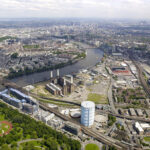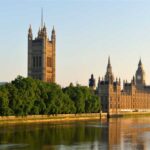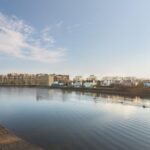Lower Lee Valley Olympics London, 2012 venue architecture UK
Lower Lee Valley London
Discussions on Current Architectural Topics – Regeneration of the City.
Degrees of Change – Olympic Site, London
Article written by architect Alan Hills
London Olympics Site : Architecture Debate
15 Sep 2005
Lower Lee Valley Olympics Site
The design thesis is an analysis of long-term thinking for the city using the site in the Lower Lee valley as a starting point. It raises questions in the flexibility of an area and questions how a building should adapt and respond to change. The issues that are researched are aimed to understand the combination of changes that led to the area in the lower lee valley being proposed as an potential Olympic site and how the site should be planned so that it becomes a part of the city.
How it might be possible to plan for uncertainty? In this case the meaning of
uncertainty is an attempt to look at factors that have not yet been established and also to look at how cumulative factors have affected the expansion and regeneration of the city. Some factors prevent change and these are just as important as those that progress it.
In separating the thesis into degrees the methodology looks at the connections between the decisions for it is in these connections that the process evolves. As the process evolves the comparable factors show connections to the future in terms of how this has affected the design process and how an area or building typology has been planned for uncertainty.
Is there a way of gauging the success of a plan or typology? It must rely on the community that uses it and the embedding of the plan into the community and making sustainable moves for the future. This could be a bus shelter or the creation of a new park or the plan for the lower Lee valley.
The purpose of the study is not just to look at the Olympics but also to draw
relevant examples to respond to the real question of how to build for the future in the city. In a constantly evolving world the paradigm shifts in thinking, planning and events affect the city in a profound way. It is these shifts that contaminate the city and make the city an exciting place to live and be a part of.
1st degree – changes that led to the promotion of the site
The Olympic committee has recognised the need for change in the way that Olympic sites are developed and how stadiums are built. In previous years expensive mega structures had left the host cities with large debts and spaces that could not be utilised by the city after the event e.g. Montreal. The more recent approach for example in Sydney and Barcelona has seen a move to the investment in the infrastructure of the city to regenerate an area of land using the games as a model to change an area of the city. Importantly it has allowed the government to borrow capital and improve the city on a large urban scale.
The paradigm shifts can be seen as changes in how the design is approached for an Olympics and also how a city works. It is a symbiosis of the IOC brief and the urban design that has led to a changing evolution of the way that we approach the treatment of the Olympic sites and the way that they are inserted into the city.
There are certain factors that re occur or that have influenced the location and changed the design within the city. In many ways this has led to the Olympics becoming a city within a city.
Security
Perhaps one of the most important aspects of the games is the level of the security required by the athletes. During the Munich Olympics in 1972 there was a security breach when a bomb was placed in the athletes accommodation. This led to a move away from the open Park arrangement to a more compact secure approach. During the Games the safety of the athletes is reflected in the design and if you separate the Olympic sites across a city then this is more difficult to achieve. As an urban strategy with more compact parks with stadiums set inside a secure perimeter have become more common place eg Sydney Olympic site.
Green issues
The IOC wants the Olympics to improve the conditions of the sites through good environmental strategies and Green peace has been very active in bringing this to the agenda. Sydney used the Olympics as a means not only to improve a contaminated site but also to embed a strategy that could be used by other cities. Beijing wants to have air cleaner than Paris for the 2008 games and whilst at the outset these ideas are exemplary they are not always achieved.
Of course transport is a major issue and has led to major improvement of city transport systems e.g. Sydney that now has a fleet of Hydrogen fuelled buses. What is a major factor is how you arrive at the Olympic site using sustainable transport systems that survive after the games. A more recent argument though has been carbon emissions from extra airplanes of visitors outweigh the local improvements.
How do you measure the Green issues? It is very difficult to measure the real successes of the Olympics but there is an agenda to improve and build upon the information that is developed during the design of the sites for the benefit of the wider communities as a knowledge base for the future.
Changes in Perception
Why have the Olympics in London? Where does London place itself in the world is one way of responding to this question? The constant reinvention of the city and the position that a city has in the world means that a city has to constantly renew itself as an attractive place to be, live, work or visit. The Olympics is about an event and about the architecture of the place. The Olympics takes place in stadiums but it is the city that becomes the back drop to the event.
In the Barcelona Olympics the games were located to regenerate an area of the city and to improve Barcelona’s status as an international city. It is very difficult to quantify this or the level of positive status that the Olympics brings to the city
via media coverage that ¾ of the worlds population watches.
Post Olympics
How can a city benefit from the Olympics after the event? It is important that there is plan to ensure that the city continues to benefit after the event. A key issue is that they are sustainable moves and relate to the local communities. If they are a success then the extra taxes, tourism and businesses have a ripple affect over a much wider area.
We can see from the Athens Olympics how many of the stadiums now lay empty in comparison to Berlin where the integration of the stadiums in the city is more successful and the reuse of the 1948 Stadium for the 2006 World cup. At what point can you measure over time the success of an Olympic site?
In urban terms in there a point when you can say that the city has finally evolved? Part of this can be seen in the degree of redundancy in the city that can be expanded into in the future in a comparison between Berlin and London.
The size and location of the site in the Lower Lee Valley is a positive aspect and has enabled a big vision for the site. Cities have to have areas to expand into but those areas of land that have not been developed often have negative factors that have restricted development. It then requires large scale investment or government intervention to invest and attract development of an area to turn an area of the city into popular destination eg Canary Wharf, Covent Garden, Tate Modern.
The context of the Olympics judged when the bid is proposed and there is no
mechanism for the evaluation of how successful the Olympic sites have been after the events.
Political Paradigm shifts
There are a series of political, social and commercial factors that have led to the London site in the lower lee valley being proposed. The London bid incorporated a Legacy proposal that would extend the benefit of the Olympics over time and allow the site to be incorporated back into the city. We can see how there are proposals to link the site back into the city and provide an urban strategy for the future.
This is not requested by the IOC and is more a political requirement that the
government wants to fulfil. This political requirement has had a huge effect on the overall urban strategy and design thought process.
There is also the political drive to include local communities in the planning
process and the office of the Deputy Prime Minister are incorporating Area
Development Frameworks that include the views of the local communities in the
process through participatory design. These views have impacted in the design and these are the views that the IOC is interested in as they have a positive impact on the area pre and post Olympics. The scenario’s of how the area is to be used and inhabited has helped to show how the urban strategy will impact on the local people, visitors and future users. The different phases in the design show how the area will change but also what is important to be kept and what value there is in the area at the moment.
This change in the planning process is so important in relocating the design
strategy as a sustainable move. Its effects are far reaching beyond the confines of a site boundary as it allows you to understand how the community as a whole will work within the proposal.
Added value
Within this idea there are other factors that give an added value to improving this
area in the Lower Lee Valley.
The idea of urban regeneration – the renaissance of the East End of London
The change in Perception of the area
The improvement of transport links in the city
To attract new investment to the Area.
To link the site back into the local community and to look at the real communities and people that live in London. Provide new jobs for the future.
To address the issue of scale and density – To change the low density site into an Olympic site and then return it back to the scale of the city. Keeping the parts that will be used by the local community and adding to it.
Catalyst of change – timeline
It is also important to remember that any urban proposal cannot solve all of the
problems in a city but is the catalyst to start changing an area for the future. The Olympics is not a perfect solution but a multifaceted approach that crosses more boundaries than just providing for a new streetscape.
Sep 2005
texts – no limit to words, we supply the colours: info(at)e-architect.com
Alan Hills is an architect based in London. This text is part of the final thesis on the completion of a masters course: any comments would be appreciated by e-mail
Location: Lee Valley, London, England, UK
London Buildings
Contemporary London Architecture
London Architecture Links – chronological list
London Architecture Walking Tours by e-architect
London Olympics Building – Velopark
Comments for the Lower Lee Valley London – 2012 Olympics Site Architecture page welcome
London, England, UK



